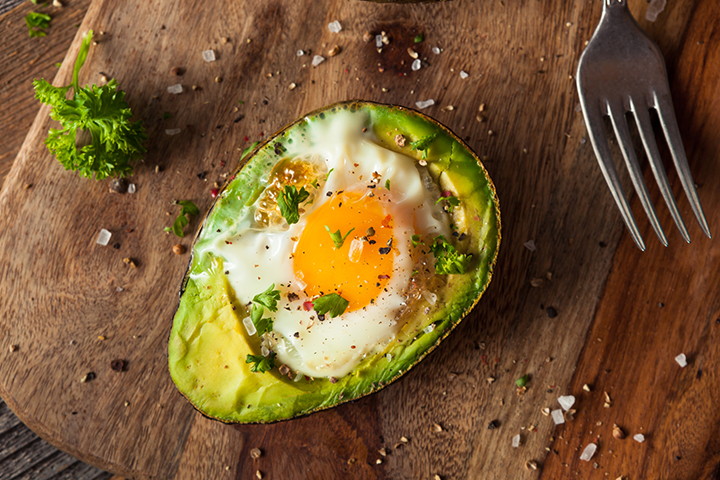
Start your day with an easy to prepare ‘protein and produce’ type breakfast, packed full of nutrients, and sugar free!
Ingredients:
- 6 avocados halved and seeded
- 6 large eggs
- salt and pepper, to taste
- 2 tablespoons chopped chives
Method:
- Preheat oven to 425 degrees F. Lightly oil a baking sheet or coat with nonstick spray.
- Using a spoon, scoop out about two tablespoons of avocado flesh, or more, as needed, creating a small well in the center of each avocado.
- Gently crack 1 egg, and slide it into the well, keeping the yolk intact. Repeat with remaining eggs; season with salt and pepper, to taste.
- Place into oven and bake until the egg whites have set but the yolks are still runny, about 15-18 minutes.
- Serve immediately, garnished with chives, if desired.
From https://damndelicious.net/2016/10/05/baked-eggs-in-avocado/
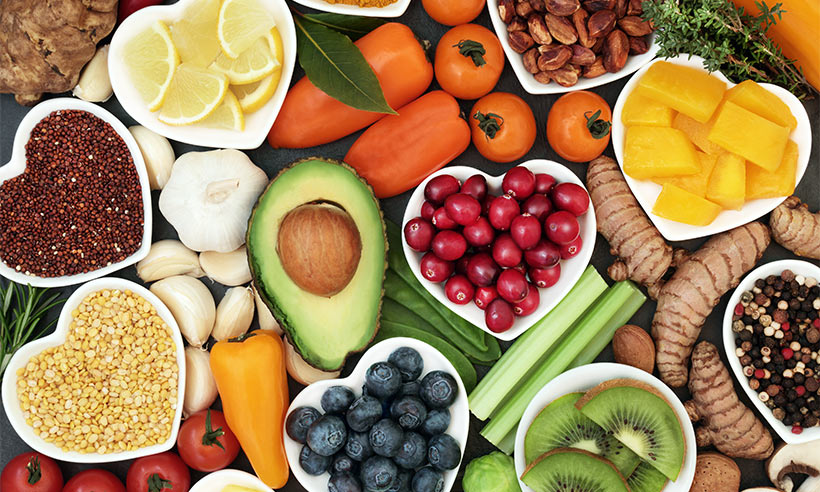
‘Veganism’. A word which is the catalyst for many debates and let’s face it, some pretty hilarious memes. However, as you have probably all noticed, the vegan lifestyle is becoming more and more popular and there seems to be an increased awareness across the board. Hopefully what follows will give you a brief insight into my life as a vegan and the effect it’s had on me, physically and mentally.
My Transition
I became vegan on the 11th of August, 2015, and I have to say it all happened pretty organically. My partner had been a vegetarian for approximately two years so my consumption of animal products had naturally reduced over that duration – but meat, eggs and dairy still made up a fair bit of my diet. She asked if I would be interested in watching a documentary called ‘Earthlings’ which looking back, was probably what started the transitioning process. I’m not going to go into the discussion of ethics – we’ve all seen the videos and anyone with an ounce of compassion can appreciate the moral justification behind veganism. Instead, I’d more like to focus on the health benefits of a plant-based diet, as this was a huge driving factor with me wanting to becoming one of those crazy extreme vegans. After viewing the documentary, I immediately dove into researching the health benefits of a vegan diet and that was “all she wrote”.
Current Diet
Now fast-forward almost 3 years and I couldn’t be happier. Now, I don’t want this article to turn into a solo episode of “This Is Your Life”, because to be honest I could talk about this stuff all day. Instead, I’ll choose three of the more significant diet-related points regarding my experience thus far with veganism.
- Micronutrients – the bottom line is that plant-based diets, when done correctly, will always result in eating a larger variety of foods. More experimentation takes part in the kitchen, more enjoyment is had with cooking, and as well as being very tasty, the meals are more colourful – and more colour means more nutrients! For example, when you’re meeting your protein requirements with foods such as beans, legumes, grains, nuts, seeds and vegetables rather than beef, chicken or fish, it’s pretty safe to say that you’re meeting many other nutrient requirements as well. Long-term, this sets you up for a far healthier and problem-free life, as you reduce your risk of chronic disease. For example, 28% of deaths in the year 2016 in Australia were a result of heart disease. A very significant factor of heart disease is atherosclerosis – the thickening and hardening of vessel walls – and a major cause of this is high cholesterol. But how many people know that dietary cholesterol solely comes from animal products, and that your liver produces enough cholesterol alone for normal bodily function? For me, the proof was in the pudding when, out of curiosity, I had a blood test in February of this year. My results were perfect, and my doctor was pretty impressed. Also, another fantastic change is that I haven’t been sick since becoming vegan, at all.
- ‘Feeling healthier’ – I have a very clear memory of 2014. I was in a ‘bulking’ phase and was consuming around 4000 calories each day. I have always strived to be the healthiest I can be, so even during this phase I was still eating plenty of vegetables and wholefoods. However, I still felt so crap. Every meal was a bigger struggle than leg day, and I was pretty lethargic the entire day. It was hard! Fast-forward to now and eating that same number of calories is entirely different. There is a noticeable difference with bloating and lethargy, and I’m generally more energetic. It’s hard to explain, but I honestly just feel healthier.
- Travelling and eating out – this is something a lot of vegan’s struggle with, but I’ve never really had a problem. Since being vegan, I’ve travelled to over 20 countries with my partner and we’ve never had an issue (thanks to wonderful apps such as HappyCow). Also, almost every restaurant has vegetarian options, and it’s never a difficult task to make these choices vegan-friendly – such as swapping out an egg or dairy product for a suitable alternative. What upsets me is hearing of complaints from the vegan community about restaurants NOT having enough vegan options. At the end of the day, veganism is in it’s infancy, and recognition on a menu in the form of a meal labelled as “Vegan” or “Vg” is a total win in my books. Recognition = awareness, and that’s the beautiful thing.
Current Training and Physical Changes
Training progress, body composition and my style of exercise have also all changed quite considerably. In addition to continuing compound strength training, I now incorporate a lot more gymnastics movements and bodyweight training into my regime and am thoroughly enjoying it. All of my personal bests for bench press, deadlifts and barbell squats have improved considerably, and I have learnt new skills such as handstands and ring muscle-ups. Could I have still achieved this as a meat eater? Probably. But, nothing feels better than going to the gym full of energy (which I didn’t always experience as a meat eater) and feeling like you can conquer anything. Also, it feels great to somewhat prove people wrong. Vegans cop a lot of flak and are always being targeted as ‘protein deficient’ or ‘malnourished’, but I’ve experienced more strength and muscle gain than ever before.
I would like to point out that I am not an expert on veganism and don’t claim to be. As I said, I strive to be well-educated and due to this point, my knowledge on diet and training is forever expanding. Also, my journey with veganism and the positive results I have experienced are just that – mine. Any diet can be done incorrectly, and individuals need to be well-educated with whatever it is they choose to consume.
Thanks so much for reading,
Matt
For information on training with Matt, contact us info@js-pt.com.au or PM us through our socials (Facebook, Instagram). For great content including vegan recipes and training videos, Matt can also be found on Facebook and Instagram.
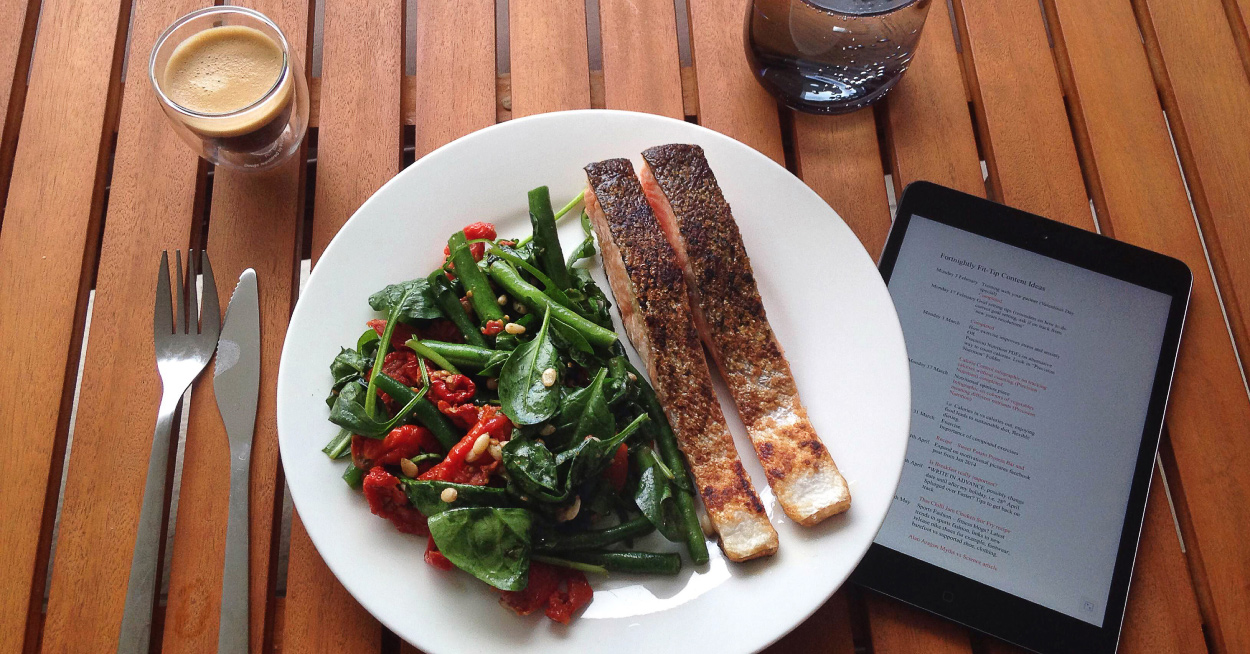
Improving your health requires changes that are sustainable for the long term. As a Precision Nutrition coach, we often provide guidance to our clients that are interested in fat loss on how to master certain food habits which will naturally lead to improved calorie control and food selection. These habits are:
1. Eat slowly and stop at 80% full
Most people (including myself) can often tend to eat their meals far too quickly, which lessens our ability to feel our hunger and appetite cues. Did you know it takes 20 minutes for our satiety mechanisms to kick in? The communication between our stomach and our brain is slow, and because of this, if we eat quickly we are far more likely to eat too much before our brain notifies us that we’re content. An excellent goal would be to aim to spend 15-20 minutes each meal. I realise this may be difficult for some so slowing down by even a few minutes will still have it’s benefits. This way, you will be able to properly gauge your fullness, which will enable you to eat until you’re ‘80% full’ which is defined as eating until you are no longer hungry, rather than eating until you’re full. This may take some practice but overall will be beneficial for your digestion, performance during your exercise, and better sleep if you’re eating before bed.
2. Eat protein dense foods with each meal
Research has shown that not only is a diet higher in protein completely safe, it may actually be important for achieving the best health, body composition (body fat % and muscle mass), and performance. The fact of the matter is, it’s hard to achieve these things with a suboptimal protein intake. By incorporating decent amounts of protein (20-30g for women, 40-60g for men) per meal, you will not only ensure you consume an adequate amount of protein, but you’ll also stimulate your metabolism, improve your muscle mass and recovery, and reduce body fat.
3. Eat vegetables with each meal
Science has demonstrated that in addition to the fibre and micronutrients (vitamins and minerals) packed into vegetables, there are also important plant chemicals called phytochemicals which are essential for optimal functioning inside our bodies. Unfortunately an inadequate vegetable intake is something I see all too often, which was reflected in Australia’s new food pyramid released earlier this year which placed vegetables (as well as fruit and legumes) as the food group we should consume the most. Given only an estimated 7% of all Australians reach their recommended intake of vegetables per day, it is something we should all aim to improve on. Including two servings of vegetables/and or fruit during each meal, not only will you regulate your overall food intake but you will also be receiving the many disease fighting benefits that vegetables provide.
4. Eat healthy fats daily
As a general rule of thumb, about 30% of your diet should come from fat, although this can change between each individual. Whilst you should focus on adding monounsaturated (extra virgin olive oil, some nuts, avocados, red meats, eggs) and polyunsaturated (some nuts, some vegetable oils, fish/fish oil) fats, including some saturated fats is ok too as a balance of all 3 types of fat is optimal. The benefits of dietary fat include the balancing of hormones, increased brain and nervous system health, and improved metabolism.
Mastering these four habits are simple and sustainable ways to improve your overall health, body composition, and performance, as your calorie control and food selection will be greatly improved.
(Inspired by the Precision Nutrition Certification Manual)
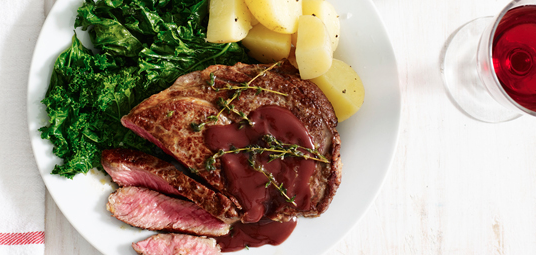
Straight from the ‘Coles Feed Your Family’ online page, this steak recipe is by former Masterchef contestant Michael Weldon. An easy variation of a simple meal with some added flavours while being high in protein and rich in vitamins and minerals.
Ingredients (serves 4):
- 4 Scotch Fillet steaks
- 2 tbsp olive oil
- 60 g butter
- 4 sprigs thyme
- 2 cloves garlic, crushed
- 150 ml red wine
- 1 tbsp brown sugar
- 2 50 g Gravox Traditional Gravy Single Tub
- 1 tbsp red wine vinegar
- 500 g kale, stalks removed (or
- 1 1/2 tbsp lemon juice
- 800 g baby washed potatoes, chopped, steamed, to serve
Method:
- Season the steaks with salt and pepper. Brush with half the oil. Heat a frying pan over high heat until very hot. Add the steaks and cook for 2 minutes. Turn and add the butter, thyme and garlic. Cook for 2 minutes for medium rare or until cooked to your liking. Baste the steak with pan juices. Transfer to a plate. Cover with foil and set aside for 5 minutes to rest.
- Meanwhile, combine the red wine and sugar in a small saucepan over a medium heat. Cook until the liquid reduces by 2/3 and the mixture is slightly syrupy. Add the Gravox and red wine vinegar. Stir over low heat to warm through. Remove from heat. Cover to keep warm.
- Heat the remaining oil and kale in a large saucepan over high heat. Stir until kale has wilted. Add the lemon juice and season with salt and pepper. Stir to combine.
- To serve, place the wilted kale on the plate. Top with steak and drizzle with the red wine sauce. Serve with steamed potatoes
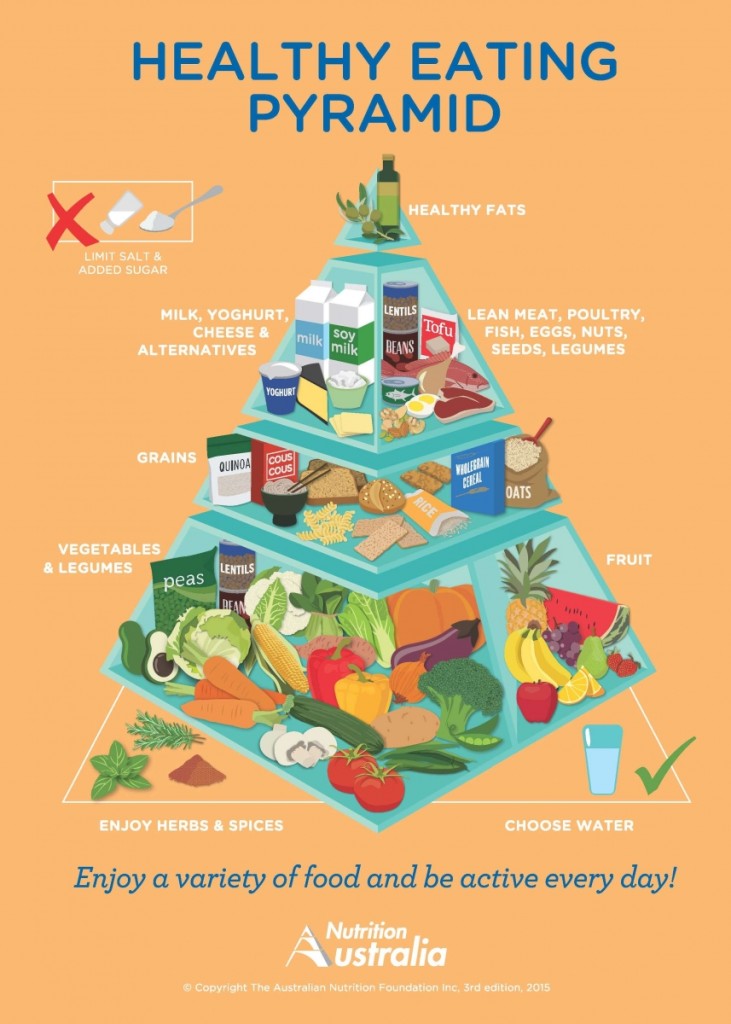
Making sense of what exactly is good and bad nutrition is a tough gig for most people. You could bet your bottom dollar that for every piece of information you find on what you should do, there will be a counter argument somewhere as to why you shouldn’t do it. Thankfully, Nutrition Australia finally released it’s new and revised food pyramid last month which aims to clear things up. Let’s take a closer look:
1. Vegetables take centre stage
The bottom layer of the food pyramid is now predominantly vegetables as well as legumes and fruit. With the high amounts of vitamins and minerals present in these foods, they have been linked to a reduced risk of a number of serious diseases such as cancer, heart disease, and type 2 diabetes.. Vegetables and fruit are also high in fibre which helps with weight control. Given an estimated (and shocking) 7% of Australians reach the recommended daily intake of vegetables, this is a good start to the new pyramid.
On a side note, while both are good options, still aim to eat more vegetables than fruit.
2. Include healthy grains
The renamed carbohydrates group has shifted up from the bottom of the pyramid to put more emphasis on Australians eating more vegetables. Carbohydrates, even with their bad reputation these days, are essential in a healthy diet and the new pyramid encourages (whole)grains such as quinoa, brown rice, multigrain breads, and oats which are also all rich in fibre. That being said, other carbohydrate options such as white rice are not poor options and can easily be included in a well balanced diet.
3. Have a mix of different sources of protein
The second top layer emphasises consuming a variety of protein sources from dairy, meat, and non meat products. While red and white meats are the obvious choices of protein, people often forget dairy products (such as cottage cheese and greek yoghurt; whey protein powder also falls in this category) are also rich in protein as well as being high in calcium.
Consuming a mixture of fish, nuts, and seeds will not only give you variety in your protein, but will also help you reach your recommended intake of healthy fats.
4. Fat is good
Fats are often neglected but they have major roles in the body which include manufacturing and balancing hormones and improving brain and nervous system health. A mix of monounsaturated and polyunsaturated fats are ideal for optimal health. They can be found in oils, avocados, nuts and seeds, fish, and eggs.
5. Junk food has been canned
The previous food pyramids had junk food at the top in the ‘eat in small amounts’ category, and whilst I think the amended food pyramid is much better, I will say that eating a small percentage (under 10% of your daily intake) on whatever you wish will not have an effect on your overall body composition and will also help you control cravings. For the average person though, not having the junk food option on the pyramid is the correct stance.
All in all, Nutrition Australia has done well with the updated version of the food pyramid. For the average person, it is a good starting point to refer to and if followed consistently would definitely improve the current eating habits of Australians unfamiliar with good nutrition practices. Putting more emphasis on vegetable intake is a much needed addition to the pyramid, and is definitely one aspect of nutrition which is hard to disagree on, regardless of what your good and bad nutrition stance is.

You can have the best nutrition plan in the world, but if your compliance to the plan is low, your results will be minimal. Those that travel for work often know all about the challenge of remaining compliant with their plan, and even those that travel occasionally can relate. If you fall into this category, then the following strategies will help you increase your adherence to a nutrition plan.
Choosing the best location
Whether you’re away for a conference for a couple of nights or working in an interstate office for the week, your first priority should be location. Not just in relation to where your work commitments are, but how close are you to supermarkets/gyms/restaurants from your hotel? Are you within walking distance? Without these type of places being close, it’s easy to make poor selections.
Choosing a room with kitchenette
Price is an obvious factor here, but a room with a kitchenette or even just a fridge, you can stock the room with healthy snacks/meals such as fresh fruit and vegetables, yoghurts, breads, sliced chicken/turkey, milk, bottled water etc.
Research restaurant menus in advance
If you intend on eating out, hop onto the websites of the possible restaurants where you intend on eating so you know what could potentially fit into your plan.
Bring protein supplements
Often the biggest challenge for people who travel often (even those who don’t) is maintaining adequate amounts of protein. If you are using the above strategies then you should be doing well to maintain sensible eating patterns, but bringing your own protein powder down is a good and quick fall back option if you aren’t able to eat as well as you would like.
While these are pretty simple steps to take when travelling, sometimes it is easier said than done to be compliant with a good eating plan. Put into place these strategies and help increase the likelihood of you remaining on track with your nutrition goals.
Inspired by Precision Nutrition
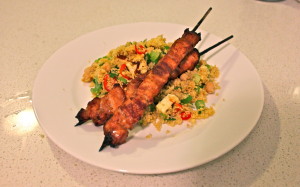
Kebabs, couscous, haloumi, and chilli. Four things I love! An easy recipe with a good amount of protein and flavour which doesn’t keep you in the kitchen for very long. Check it out below.
—
For the Couscous salad:
Method:
1. Bring stock to boil in a saucepan over high heat. Place couscous in a large bowl and pour the boiling stock over. Stir through with a fork. Leave covered for 5 minutes and stir through with a fork again to separate the grains.
2. Cut up haloumi into smaller pieces. Heat saucepan with oil over medium heat, and add haloumi. Cook for approximately 1-2 minutes each side or until golden brown.
3. Add haloumi to couscous along with spring onions, chilli, and chickpeas.
4. Make the dressing: whisk lemon rind, 1/4 cup lemon juice, paprika and oil in a bowl until properly combined.
5. Pour dressing over salad. Serve!
For the chicken kebabs:
Method:
1. Preheat a BBQ or pan on medium high, cook the kebabs while turning until properly cooked through.
2. Serve!

This breakfast/dessert idea is so simple a recipe is hardly needed. Here’s how it was done anyway.
Serves 1
1 ripe banana, peeled
1/2 cup Greek yogurt
2 tablespoons fruit jam or preserves
2 tablespoons sliced almonds or other nuts OR granola as is in the photo
1/4 cup fresh berries or other fresh fruit
Split the banana lengthwise and lay the two halves in a shallow bowl. Scoop out the yogurt and put it on top of the banana. Warm the jam in the microwave for 15 to 30 seconds or until it is very runny.
Use a spoon to drizzle the jam over the yogurt, and sprinkle the granola/nuts over everything. Top with raspberries/blueberries and dig in!
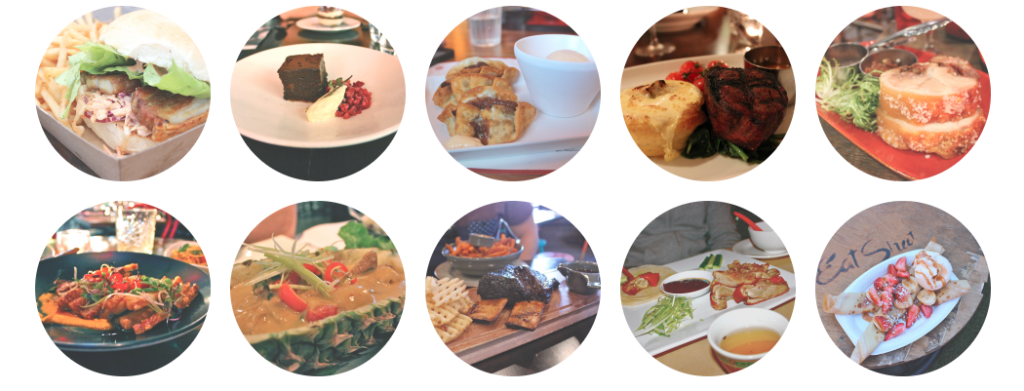
Strict ‘all or nothing’ approaches to food plans for clients are common amongst personal trainers and nutritionists. Often they result in failure due to their lack of flexibility. I’m all for being fit, healthy, and looking the part, but if a diet doesn’t have variety or allow me to indulge in foods I love, I’m not interested. Nonetheless, there is a diet option where you can literally, ‘have your cake and eat it too,’ and that’s by applying the moderation guideline. The moderation guideline is the 10-20% rule which is outlined in greater detail by leading nutritionist Alan Aragon.
In essence, the 10-20% rule allows you to eat whatever you want but still look great naked! Well, not quite, but with all things in life, everything should be in moderation. The basis of your diet should still come from whole and minimally refined foods. Reaching your minimum daily protein and fat intake (which varies for each individual) is still vital. If you are ticking these boxes, then consuming your go to indulgence foods is perfectly fine, as long as they are in moderation (10-20% of your daily Calorie target). Often dieting is too much of a psychological battle to stay within the parameters of a food plan because of lack of flexibility and variety, but with the 10-20% rule, this allows for indulgences more often than just the common ‘cheat meal.’ Of course, if someone chooses to have 0% of their food coming from sweets or processed food, that’s also perfectly fine.
As Alan Aragon has said, “Honouring personal preference is one of the most powerful yet underrated tactics for achieving optimal health and body composition.” Remember though, greater dietary flexibility is achieved by how high or low your physical activity levels are. So basically, consistent exercise is very important.
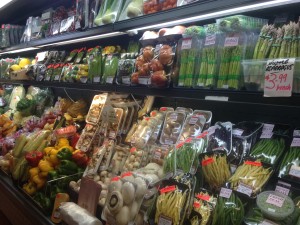
Superior Fruit Graceville
I’m sure many of you are familiar with, have seen or have heard of the glycemic index (GI). You know, those commercials and food labels that tell you why a particular food is more healthy because it is ‘low GI’. In short, the GI is a measure of how quickly a given food can raise blood sugar. The test is done solely on a specific carbohydrate food with a score between 1-100.
High GI foods such as sugar, white potatoes, cereal etc raise blood sugar more quickly, thus are scored higher. Low GI foods such as whole grains, nuts and vegetables do not cause the same rises in blood sugar, so are scored lower… But, do all the meals we consume only consist of high GI foods, or low GI foods? No. They are often a mix of both.
Consuming a high GI food (for example white potatoes) as part of a mixed meal of lower GI foods (vegetables, legumes) with a lean protein, would more than likely mean the overall GI of the meal is quite low. The vegetables and legumes in this case may slow the digestion of the white potatoes.
What does this mean for you?
Well, while you may see a lot of marketing to do with high GI and low GI foods, or have heard of people cutting out potatoes because of their GI score, just remember the GI index should not govern someone’s carbohydrate choices exclusively. Many different types of food both low and high GI have a wide range of vitamins and minerals which can benefit your health.
Eat a variety of whole and minimally processed foods and enjoy what is on your plate!
The best diets are the ones that consume all sorts of nutrients, as well as improve the performance, body composition (the amount of lean mass and fat mass present; basically how you look) and health of that individual.
To have a diet which contains all types of nutrients, you need to have VARIETY! Eating the same things each day, even if they are considered ‘good’ foods, means you are likely deficient in other areas of your nutrition.
Eat for your own health, your own performance, and your own body composition, but do yourself the favour and achieve all of that by eating a wide range of foods.
“Variety is the spice of life”

Healthy eating doesn’t have to mean you avoid the foods you love, nor does it have to mean hours and hours of food prep. Check out this recipe below for a simple and easy to prepare Thai dish (who doesn’t like Thai food?) which contains a great mix of macronutrients, and most importantly is delicious!
Method:
Step 1: Heat half the oil in a wok over high heat until just smoking. Add the almonds and stir-fry for 1 minute or until golden. Transfer to a heatproof bowl.
Step 2: Add half the chicken to the wok and stir-fry for 2 minutes or until brown. Transfer the chicken to the bowl with the almonds. Repeat with the remaining chicken, reheating wok between batches.
Step 3: Heat the remaining oil in the wok. Add the onion, broccolini, chilli and garlic and stir-fry for 2 minutes or until the broccolini is bright green and tender crisp. Add almonds, chicken, shallot and chilli jam and stir-fry for 2 minutes or until heated through.
Step 4: Spoon the stir-fry among serving bowls. Sprinkle with basil and serve with steamed rice.











